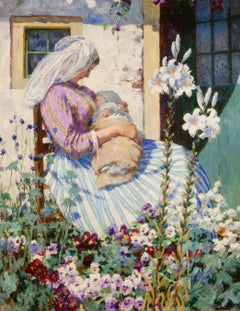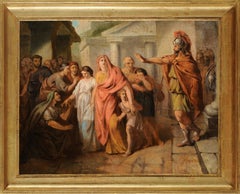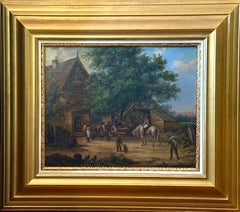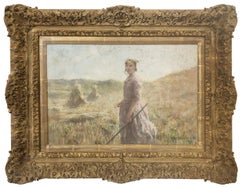George Hitchcock Art
George Hitchcock is best known for his impressionistic pictures of brilliantly colored Dutch tulip fields, Dutch peasant women and mystical religious scenes. During his lifetime, Hitchcock was one of the best known of the American expatriate painters and held membership in prestigious academies and associations in the United States and abroad. Hitchcock was born in 1850 in Providence, Rhode Island, to a prominent family who could trace its ancestry back to the colony’s founder Roger Williams. Hitchcock attended Brown University, graduating in 1872 and Harvard Law, graduating in 1874. Admitted to the Bar in Rhode Island and New York, he practiced law for five years, before feeling the pull of an artistic career. In 1879, Hitchcock arrived in London and attended the Heatherley’s School of Fine Art. He supplemented his initial artistic training with a year in Paris, where he studied at the Académie Julian with the painters Jules Lefebvre and Gustave Boulanger; a winter at the Academy in Düsseldorf, and two summers studying in the Hague with the Dutch marine painter Hendrik Willem Mesdag. Hitchcock debuted at the Salon in Paris in 1887 with Tulip Culture, a picture depicting a peasant woman walking in a field of tulips. This painting earned Hitchcock an honorable mention and established his reputation for being the Impressionist interpreter of the Dutch countryside. During the 1880s, Hitchcock and another American expatriate painter Gari Melchers established an artists colony in the group of small villages of Egmond on the Dutch coast. Hitchcock settled in Schuylenburg house in Egmond-aan-den-Hoef, and painted the ordinary people going about their daily lives in a light Impressionist style. Hitchcock and Melchers welcomed more than 300 students to the region over the course of two decades and witnessed the establishment of 17 studios. Hitchcock’s mature style combines many different elements from his artistic training. From the Barbizon School of landscape painting, Hitchcock adopted a lighter palette, expressive brushwork, and an affinity for painting en plein air or outdoors. The dignity, monumentality and mysticism with which the French Naturalist painter Jules Bastien-Lepage imbued his peasants are manifest in Hitchcock’s treatment of the Dutch peasants of Egmond and the high-keyed, light infused palette and broken brushstrokes of the Impressionists gave Hitchcock the idiom with which he pictured the Dutch countryside and its inhabitants
Late 19th Century George Hitchcock Art
Canvas, Oil
1780s French School George Hitchcock Art
Canvas, Oil
19th Century Victorian George Hitchcock Art
Canvas, Oil
18th Century Old Masters George Hitchcock Art
Canvas, Oil
1840s French School George Hitchcock Art
Canvas, Oil
Mid-19th Century Naturalistic George Hitchcock Art
Canvas, Oil
2010s Expressionist George Hitchcock Art
Canvas, Oil
21st Century and Contemporary Contemporary George Hitchcock Art
Oil, Canvas
1850s French School George Hitchcock Art
Oil, Canvas
2010s Realist George Hitchcock Art
Oil, Canvas
Early 1900s Academic George Hitchcock Art
Oil, Canvas
2010s Other Art Style George Hitchcock Art
Canvas, Oil
19th Century George Hitchcock Art
Canvas, Oil
1870s American Impressionist George Hitchcock Art
Pastel, Archival Paper



